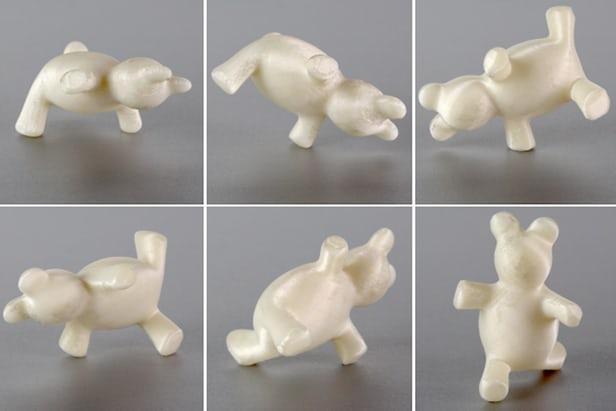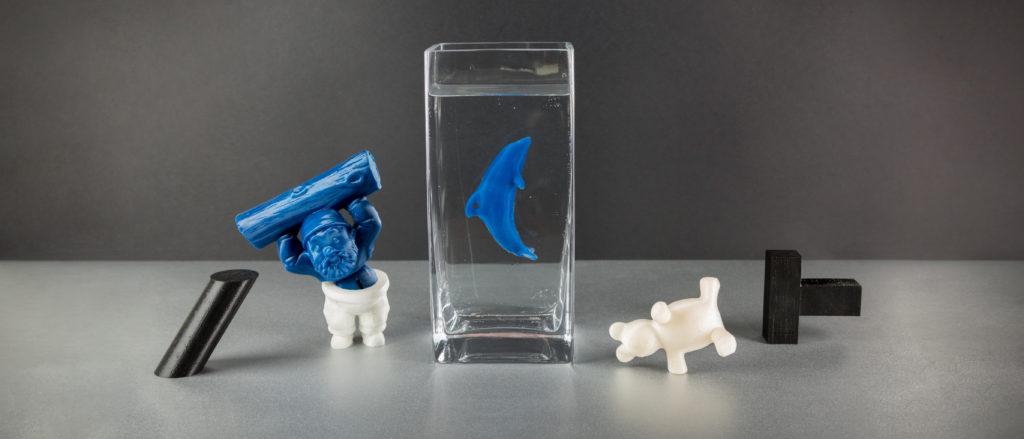Disney Research Devises a Method of 3D Printing Models That Balance or Breakdance
 It’s incredibly frustrating when you spend hours – or days – designing and 3D printing a perfect figurine or other decorative object only to have it refuse to stand up properly, or fall over every time you shut a door somewhere in the vicinity. That’s the reality of 3D printing, though, as well as other methods of toy manufacturing – even the most well-crafted figurines can have infuriating balance issues. Imagine, though, that you could 3D print a figure that not only retains a solid center of gravity while standing, but can also effortlessly balance on its head or side. Intriguing, no?
It’s incredibly frustrating when you spend hours – or days – designing and 3D printing a perfect figurine or other decorative object only to have it refuse to stand up properly, or fall over every time you shut a door somewhere in the vicinity. That’s the reality of 3D printing, though, as well as other methods of toy manufacturing – even the most well-crafted figurines can have infuriating balance issues. Imagine, though, that you could 3D print a figure that not only retains a solid center of gravity while standing, but can also effortlessly balance on its head or side. Intriguing, no?
The latest project from Disney Research, which is often busy with impressive projects involving 3D technologies, involves the creation of 3D printed objects capable of performing gravity-defying feats of balance. Check out this breakdancing teddy bear:
It all comes down to metal balls embedded inside the 3D printed object. The research team, in a paper entitled “Balancing 3D Models with Movable Masses,” describes a 3D design process that includes hollow cavities, or “capsules,” in which the metal balls can be placed during printing. The number and placement of the balls depends on the position or positions the designer wants the object to be able to hold. For example, “Breakdancing Teddy” can hold a total of six stable poses thanks to two strategically placed capsules.
“With embedded movable masses, we have the unique capability to satisfy multiple balancing objectives simultaneously,” the research team explains. “Depending on the pose of the model, the masses will be at different locations, resulting in different centers of mass. With a single center of mass, most objectives would be incompatible. Therefore, we introduce an optimization able to handle a multitude of objectives.”
It’s a delicate, precise design process that involves a lot of careful calculations to ensure that the metal balls roll into the proper positions to create stable centers of gravity. Disney Research, however, wants to create a system that even beginners can take advantage of. With a software system the team is creating, the user would design a model as usual, but also indicate the different ways the object should stand or balance. The algorithms would then use those parameters to add one or more hollow capsules to the design, their shapes, sizes and locations automatically calculated and optimized.
 While printing the object, the user will need to pause the process to place the balls into the capsules, and then continue. When the print is finished, the object should easily balance in one or more positions, exactly as the designer envisioned. It’s not just standing objects, either – the capsules can be placed so that an object will float or hang in a precise orientation, like this dolphin (left). When submerged in water, the dolphin floats with its nose pointed upward, while when suspended from a string its nose points downward as if it’s midway through a graceful dive.
While printing the object, the user will need to pause the process to place the balls into the capsules, and then continue. When the print is finished, the object should easily balance in one or more positions, exactly as the designer envisioned. It’s not just standing objects, either – the capsules can be placed so that an object will float or hang in a precise orientation, like this dolphin (left). When submerged in water, the dolphin floats with its nose pointed upward, while when suspended from a string its nose points downward as if it’s midway through a graceful dive.
“For fabrication, we rely on fused deposition modeling (FDM),” the team continues. “Many FDM technologies support the fabrication of curvature-bound overhangs without the need for a supporting structure. This enables fabrication of our models with embedded metallic balls without the need for introducing cuts nor relying on a manual assembly after fabrication. We can simply pause the printer, place a ball, and then resume printing. To enable this placement during printing, we need to guarantee that the two end points are at least a radius length apart, leading to additional constraints. For technologies other than FDM, manual cutting and assembly is unavoidable, rendering the above constraints unnecessary.”
 The team’s research isn’t nearly complete yet; they also plan to experiment with using fluid or granular materials like sand in place of the metal balls, which would require a simulation-based design approach.
The team’s research isn’t nearly complete yet; they also plan to experiment with using fluid or granular materials like sand in place of the metal balls, which would require a simulation-based design approach.
“As another interesting direction, we would like to extend our method to design dynamically balanced models,” the research team adds. “Lastly, a design system for the full spacetime control of physical models through optimal conversion between potential and kinetic energy is an interesting but ambitious extension of our work.”
In addition to Disney Researchers Romain Prévost and Moritz Bächer, the paper was also co-authored by Wojciech Jarosz of Dartmouth College and Olga Sorkine-Hornung of ETH Zurich. You can read the full study here. Discuss further in the Disney Researchers Create 3D Prints that Balance forum over at 3DPB.com.
[All images: Disney Research]Subscribe to Our Email Newsletter
Stay up-to-date on all the latest news from the 3D printing industry and receive information and offers from third party vendors.
Print Services
You May Also Like
Low-cost “Suzy” Polymer Powder 3D Printer is Faster and Cheaper than Past Models
Polish laser powder bed fusion (LPBF) firm Sinterit has released a follow-up to its predecessors, Lisa and Nils, called Suzy, a $19,490 printer equipped with a 30W fiber diode laser....
India’s $58M Space Fund Is a Boon for AM Innovation
India’s space industry is picking up serious momentum. With a projected $44 billion space economy by 2033, the country is aggressively expanding its capabilities, fostering private-sector participation, and reducing its...
Japanese Advanced Manufacturing Capabilities Grow in Europe with Sodick’s Purchase of Prima Additive
The global economy is currently undergoing a reshuffling in terms of what gets manufactured where. In large part, this trend is being driven by new geopolitical alliances and the need...
Bosch Invests €6M into Serial Auto Part 3D Printing
German industrial conglomerate Robert Bosch GmbH, the world’s largest supplier of automotive parts, has announced a new investment into Nuremberg, Germany additive manufacturing (AM) facility. The nearly €6 million in...





























